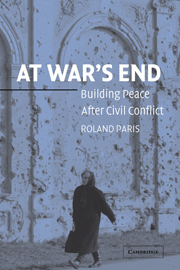1 - The Origins of Peacebuilding
Published online by Cambridge University Press: 05 September 2012
Summary
As the Cold War was coming to a close in 1989, the United Nations launched its first major peacebuilding mission in Namibia, following the negotiation of a peace settlement in that country's decades-long civil war. At that time, few observers predicted that postconflict peacebuilding would become an international growth industry, but over the next decade, operations were deployed to no fewer than thirteen other territories that were just emerging from internal conflicts.
Ostensibly, these missions provided “technical assistance” to local actors in war-torn countries – assistance aimed at preventing the recurrence of violence and establishing a stable and lasting peace. In practice, however, these operations were more than merely technical (or ideologically neutral) exercises in conflict management. As we shall see, they all promoted a particular model of political and economic organization: liberal market democracy. Why did peacebuilders embrace democratization and marketization as strategies for preventing renewed violence? And why did this brand of peacebuilding proliferate so rapidly in the 1990s? Answers to both of these questions can be found in the peculiar political and ideological conditions that prevailed at the end of the Cold War, when peacebuilding came into being.
The Cold War's End and the Rise of Peacebuilding
During the Cold War, the UN's main security activity was “peacekeeping,” which typically involved the deployment of a lightly armed military force to monitor a cease-fire or patrol neutral buffer zones between former combatants.
- Type
- Chapter
- Information
- At War's EndBuilding Peace after Civil Conflict, pp. 13 - 39Publisher: Cambridge University PressPrint publication year: 2004
- 2
- Cited by

